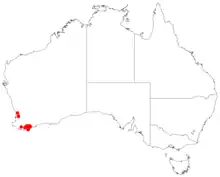| Leucopogon lasiophyllus | |
|---|---|
| Scientific classification | |
| Kingdom: | Plantae |
| Clade: | Tracheophytes |
| Clade: | Angiosperms |
| Clade: | Eudicots |
| Clade: | Asterids |
| Order: | Ericales |
| Family: | Ericaceae |
| Genus: | Leucopogon |
| Species: | L. lasiophyllus |
| Binomial name | |
| Leucopogon lasiophyllus | |
 | |
| Occurrence data from AVH | |
| Synonyms[1] | |
|
Styphelia lasiophylla (Stschegl.) Sleumer | |
Leucopogon lasiophyllus is a species of flowering plant in the heath family Ericaceae and is endemic to the south-west of Western Australia. It is an erect shrub with linear to lance-shaped leaves and small, dense spikes of tube-shaped white flowers on the ends of branches and in leaf axils.
Description
Leucopogon lasiophyllus is an erect shrub that typically grows to a height of 0.3–1 m (1 ft 0 in – 3 ft 3 in) and has its branches and foliage covered with short, rigid hairs. The leaves are linear to lance-shaped with a blunt tip, 4–9 mm (0.16–0.35 in) long and prominently ribbed. The flowers are arranged in small, short, dense spike on the ends of branches or in upper leaf axils with leaf-like bracts and tapering bracteoles about half as long as the sepals. The sepals are softly hairy, 2.6–3.1 mm (0.10–0.12 in) long and the petals white and 4.2 mm (0.17 in) long, the lobes about the same length as the petal tube.[2][3]
Taxonomy
Leucopogon lasiophyllus was first formally described in 1859 by Sergei Sergeyevich Sheglejev in the Bulletin de la Société impériale des naturalistes de Moscou from specimens collected by James Drummond.[4][5] The specific epithet (lasiophyllus) means "shaggy- or woolly-hairy leaved".[6]
Distribution and habitat
This leucopogon grows on hillsides in sandy or stony soils in the Esperance Plains bioregion of south-western Western Australia.[3]
Conservation status
Leucopogon lasiophyllus is listed as "Priority Four" by the Government of Western Australia Department of Biodiversity, Conservation and Attractions,[3] meaning that it is rare or near threatened.[7]
References
- 1 2 "Leucopogon lasiophyllus". Australian Plant Census. Retrieved 10 January 2023.
- ↑ Bentham, George (1868). Flora Australiensis. Vol. 4. London: Lovell Reeve & Co. p. 200. Retrieved 10 January 2023.
- 1 2 3 "Leucopogon lasiophyllus". FloraBase. Western Australian Government Department of Biodiversity, Conservation and Attractions.
- ↑ "Leucopogon lasiophyllus". APNI. Retrieved 10 January 2023.
- ↑ Sheglejev, Sergei Sergeyevich (1859). "Epacridearum Novarum". Bulletin de la Société impériale des naturalistes de Moscou. 32 (1): 16. Retrieved 10 January 2023.
- ↑ Sharr, Francis Aubi; George, Alex (2019). Western Australian Plant Names and Their Meanings (3rd ed.). Kardinya, WA: Four Gables Press. p. 235. ISBN 9780958034180.
- ↑ "Conservation codes for Western Australian Flora and Fauna" (PDF). Government of Western Australia Department of Parks and Wildlife. Retrieved 10 January 2023.